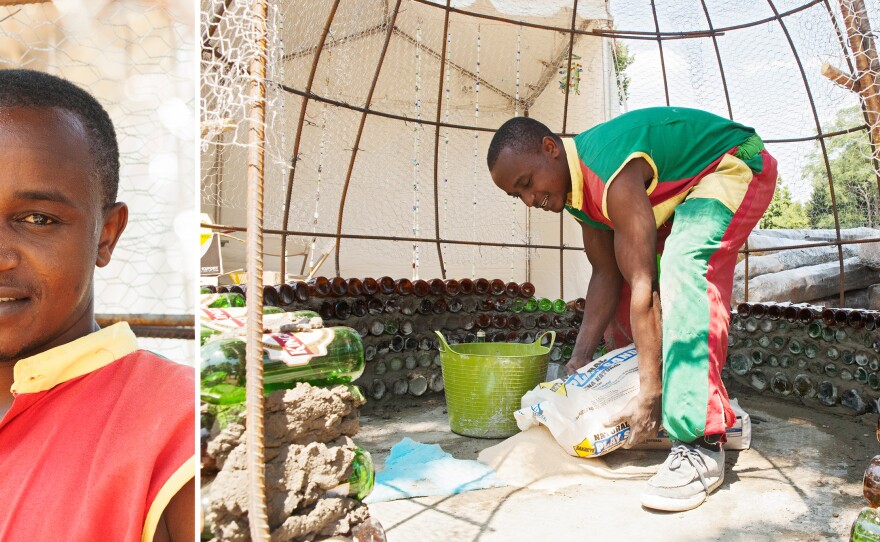Sure, it's tough to earn a living as an artist. But it helps if your materials don't cost a lot. At the Smithsonian Folklife Festival, several of the Kenyan craftspeople work wonders with discarded beer bottles and flip-flops.
Jonathan Lento: He Fashions Flip-Flops Into Funky Fauna
Jonathan Lento grips a slender knife in one hand and a colorful block made of glued-together flip-flops in the other.
He carves away at the block, unearthing the wild beast within. He chips a few more bits and sands the rough spots to reveal a blue gorilla, which he places next to a hippo, a dolphin and a rhino, all carved from flip-flops.
The sculptures aren't just a fun project. They're part of the artist's marine conservation efforts. Ocean trash is a threat to sea turtles, he explains. They might try to eat a floating flip-flop, choke and die.
Lento's organization, Ocean Sole, partners with the Kenya Lamu Marine Conservation Trust to collect flip-flops from Kenya's Indian Ocean coast. The goal is to gather 400,000 a year. Community members find the flip-flops; Ocean Sole buys them, cleans them, then crafts them into sculptures to sell.
Lento says his favorite is a 7-foot-tall giraffe, which was on display at the Folklife Festival. Its Styrofoam skeleton is covered with flip-flop pieces of pink and yellow and red and green.
"This is one way of cleaning our environments — that's why we make these sculptures," he says. Visitors to the festival "oohed" and "aahed" at the giraffe — and got a lesson from Lento in the plight of the sea turtle.
-- Nicholas St. Fleur
Apollo Omondi Omware: A Fruitless Job Hunt Led To A Career In Crafts
Like many young, ambitious men, Apollo Omondi Omware wanted to find a white-collar job. Something in a nice office, with a nice salary.
He tried, applying for positions in Kisumu, a bustling port city on the Kenyan shore of Lake Victoria.
But Omware had no luck. So he followed a different dream. He began dabbling in crafts.
Omware learned to weave baskets. With a pair of pliers and a hammer, he transformed soda caps into earrings and necklaces. "At first it was hard — very hard," he says.
But basket by basket, earring by earring, his small dream turned into a company. Today Omware runs a workshop that employs 35 young men. He pays them by the piece to motivate them to work harder: "If you make five baskets, I'll pay you $5."
Tourists are the main target audience for the items. He sells them in a gift shop attached to his workshop in Kisumu. Trendy Kenyan urbanites are interested as well, he says; locals close to their rural roots are not.
Omware also works with Zingira Nyanza Community Crafts, which helps tribal artisans near Kisumu develop a market for their crafts. The cooperative sells everything from cards made of recycled paper and banana fiber to tin mobiles and bookmarks.
For his crafts, the budding entrepreneur has built relationships with city kids and women who live in villages bordering Lake Victoria. The youngsters get a kick out of bringing in discarded soda caps. He doesn't pay them: "That would be child labor," he says. He makes an exception for street children: "We tell them, 'Collect for us, we'll give you something.' "
He definitely pays the women. They know how to make rope out of the stems of water hyacinths, an invasive plant from South America that clogs Lake Victoria. It's perfect for basket weaving.
"They get something, I get something," says Omware. "It's a chain. Everybody's benefiting."
There's a nice touch of symmetry in his artistic enterprise. The young men hired for his workshop have come to the city looking for those hard-to-find white-collar jobs, just as Apollo Omondi Omware once did.
-- Marc Silver

Isaac Kibe: There's A Message In His Bottles
Isaac Kibe mixes up a slurry of powdered cement and water. Compactly built and tautly muscled, he is 40 but looks years younger, especially when he flashes a shy grin. He uses the gray paste to place one more empty beer bottle into an igloo he is building on the National Mall in Washington, D.C. The brown and green bottles sparkle in the sunlight.
Back home in Kenya, Kibe is a master of recycled art. He takes the trash that litters his city's streets — beer bottles, broken mirrors and ceramic tiles — and uses it to create mosaics, sculptures and even houses big enough to live in.
"There were so many bottles in the city," he said. "I have a bottle bank where people come and drop, and drop, and drop until it's overflowing."
Working at the Kitengela Hot Glass studio on the border of Nairobi National Park, Kibe melts some of the glass to create beads for jewelry and to shape into sculptures. But many bottles are preserved intact; they form the base for domed huts that are often used as a decorative element for a yard or a hotel's grounds.
Kibe has made a living out of recycling glass into artwork for eight years. "I enjoy what I'm doing," he says. He's happy that his work is cleaning up his community — and bringing new opportunities for Kenya's youth.
He has taught more than 30 young people the art of making mosaics, and now they're part of his team, handling requests for floors and walls.
"Our youth now have jobs," he tells Goats and Soda. "We're giving back to the community by showing them what they can do for themselves."
And he's doing good for himself as well: "I'm keeping fit!"
-- Nicholas St. Fleur
Copyright 2022 NPR. To see more, visit https://www.npr.org. 9(MDAzMjM2NDYzMDEyMzc1Njk5NjAxNzY3OQ001))






